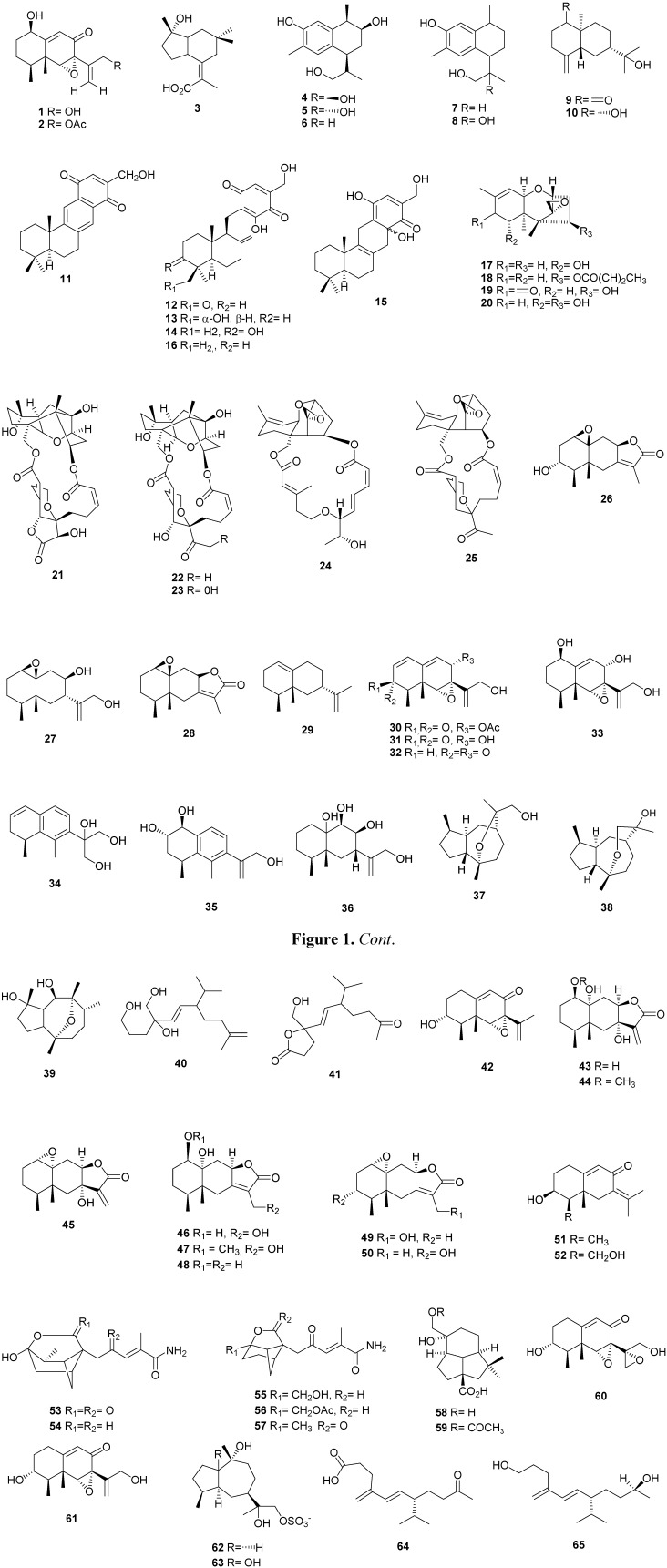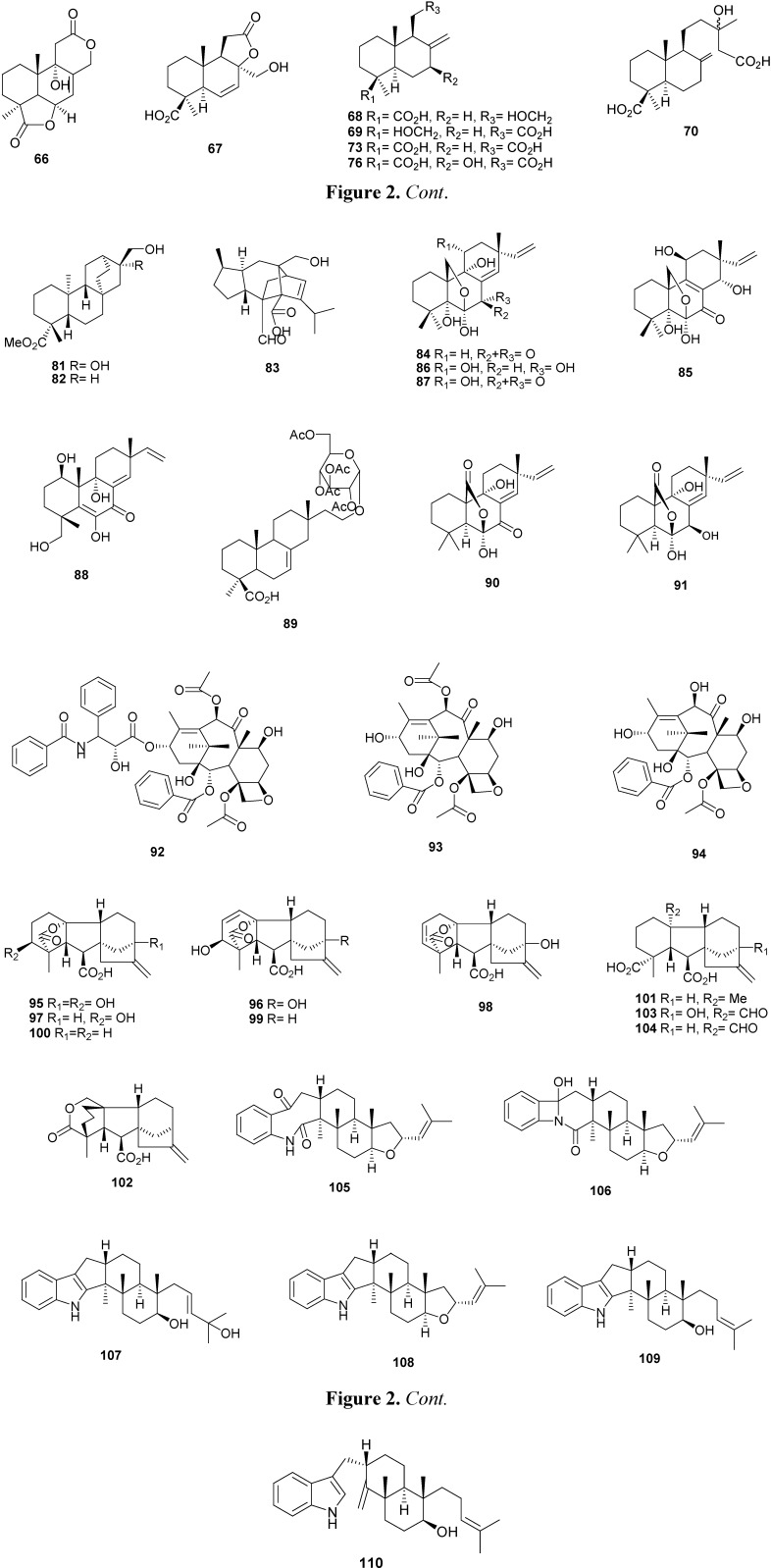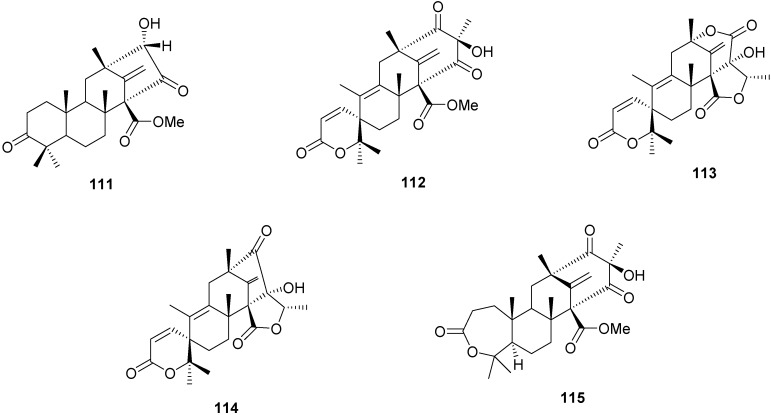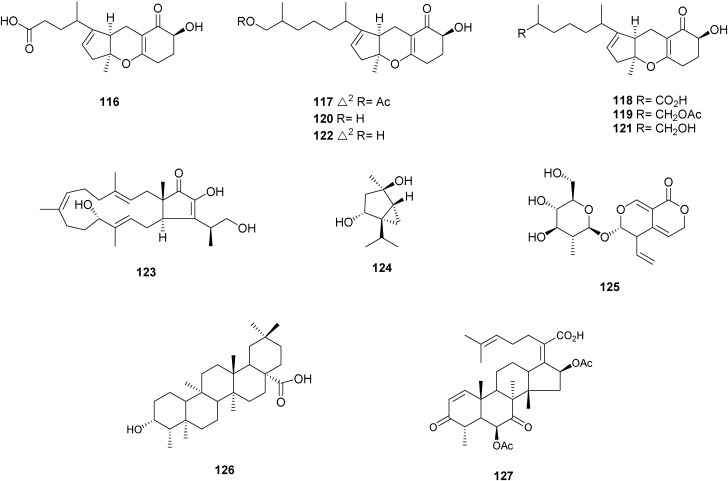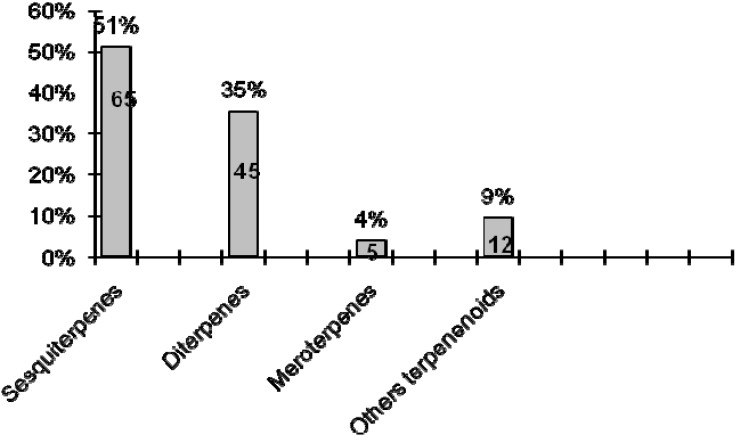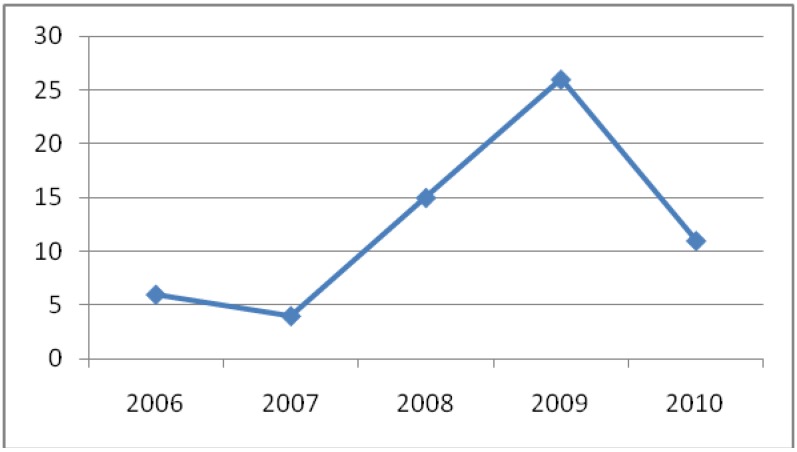Abstract
This work reviews the production of terpenoids by endophytic fungi and their biological activities, in period of 2006 to 2010. Sixty five sesquiterpenes, 45 diterpenes, five meroterpenes and 12 other terpenes, amounting to 127 terpenoids were isolated from endophytic fungi.
Keywords: endophytic fungus, terpenoids, antimicrobial activity
1. Introduction
Endophytic microorganisms are bacteria or fungi that live inside plant tissues at any moment of their life cycle, without causing damage or disease symptoms to their hosts [1,2,3,4,5]. Endophytic microorganisms can be transmitted to other plant generations by seeds or vegetative propagules, allowing wide distribution of these microorganisms in plants [6]. The colonization and propagation of these microorganisms can offer a significant benefit to their host plants by producing a plethora of metabolites that provide protection and help the survival of the plants [5]. These secondary metabolites are particularly active due to metabolic interactions with their hosts [7,8,9].
Recently, endophytes have been recognized as important sources of a variety of new biologically active secondary metabolites potentially useful for human medicine, with anticancer, antimicrobial and other activities [4,7,10,11,12], and also could be potential sources of novel natural products with industrial and agrochemical potential [5,13]. The selection of the host plant is important factor for the production of endophytic fungi and the isolation of their bioactive secondary metabolites [12,14]. This work summarizes the reported terpenoids isolated from endophytic fungi, their hosts and biological activities.
2. Terpenoids
2.1. Sesquiterpenes
The xylarenones A (1) and B (2), and xylarenic acid (3) (Figure 1) were obtained from the endophytic fungus Xylaria sp. NCY2, obtained from Torreya jackii CHUN. These compounds were tested in vitro in antitumor and antimicrobial assays in which they exhibited moderate antitumor activities against HeLa cells [15]. Five cadinane sesquiterpene derivatives, two diastereoisomeric 3,9,12-trihydroxycalamenenes 4 and 5, 3,12-dihydroxycalamenene (6), 3,12-dihydroxycadalene (7) and 3,11,12-trihydroxycadalene (8) (Figure 1) were isolated from Phomopsis cassiae collected from Cassia spectabilis [16]. The antifungal activity of compounds 4–8 was evaluated against the phytopatogenic fungi Cladosporium cladosporioids and C. sphaerospermum. Compound 7 exhibited potent activity against both fungi. The cytotoxicity of the compounds 4–8 against HeLa cells was tested and compound 7 exhibited cytotoxicity withIC50 of 20 µmol/L, and 6 and 8 were weakly active (IC50 of 100 and 110 µmol/L, respectively). Two ent-eudesmane sesquiterpenes, ent-4(15)-eudesmen-11-ol-1-one (9) and ent-4(15)-eudesmen-1R, 11-diol (10) (Figure 1) were isolated from the endophytic fungus Eutypella sp. BCC 13199 from the plant Etlingera littoralis [17]. Five sesquiterpene quinones, (+)-(5S,10S)-4′-hydroxymethylcyclozonarone (11) 3-ketotauranin (12), 3α-hydroxytauranin (13), 12-hydroxytauranin (14) and phyllospinarone (15), and tauranin (16) (Figure 1) were isolated from Phyllosticta spinarum, a fungal strain endophytic in Platycladus orientalis. All compounds were evaluated for their cell proliferation inhibitory activity in a panel of five cancer cell lines, and only 16 showed any activity against PC-3M (prostate) and NIH 3T3 (mouse fibroblast) [18]. KLAR 5, an endophyte isolated from the twigs of Knema laurina (Blume) Warb., produced the trichothecene 7α-hydroxyscirpene (17) together with 8-deoxytrichothecin (18), trichothecolone (19) and 7α-hydroxy-trichodermol (20) (Figure 1). The compounds 18 and 20 were selectively active against human breast cancer (BC-1) and human small cell lung cancer (NCI-H187). Compounds 17 and 19 were moderately active against human epidermoid carcinoma of the mouth, BC-1 and NCI-H187 cancer cell lines [19]. From the Myrothecium roridum IFB-E009, was isolated the 10,13-cyclotrichothecane-derived macrolide myrothecine C (21) and M. roridum IFB-E012 produced two myrothecines, A (22) and B (23), mytoxin B (24) and roridin E (25) (Figure 1). These two fungi were isolated from the traditional Chinese medicinal plants, Trachelospermum jasminoides and Artemisia annua, respectively. Compounds 21–25 showed significant activities against the human tumor cell line nasopharyngeal epidermoid KB [20]. Four eremophilane sesquiterpenes, cupressolides A (26) and B (27), mairetolide A (28) and valencene (29) (Figure 1) has obtained of Xylaria sp., isolated from health tissues of Cupressus lusitanica [21]. Microdiplodia sp. KS 75-1 from the stem of Pinus sp. produced four eremophilane sesquiterpenes 8α-acetoxyphomadecalin C (30), phomadecalins C–E (31–33) (Figure 1).
Figure 1.
Chemical structures of sesquiterpenes from endophytic fungi.
Compounds 30 and 31 showed moderate activities against Pseudomonas aeruginosa ATCC 15442, with inhibition zones of 12 mm and 11 mm in diameter at a concentration of 200 µg/disk, respectively [22]. Tubercularia sp. TF5, an endophytic fungal strain isolated from the medicinal plant Taxus mairei, was submitted to protoplast mutations and genome shuffling, with UV and NTG, and two important mutants, M-741 and G-444, were selected for metabolites isolation and determination due to their phenotypes [23]. Three eremophilane-type sesquiterpenoids, tuberculariols A-C (34–36) (Figure 1) isolated from strain M-741, showed no inhibitory activities against Saccharomuyces cerivisiae ATCC9763, Escherichia coli CMCC44103, and Candida albicans AS2.538, and only weak inhibitory activity against HeLa cell line [23]. From the transformed strain G-444, five sesquiterpenoids, namely 10,11-epoxy-12-guaianol (37), 10,12-epoxy-11-guaianol (38), a backbone rearranged sesquiterpene derived from guaiane (39), two 1,5/1,10-diseco-guaianes (40/41) and sporogen-AO1 (42) (Figure 1) were isolated [24]. Scale up fermentation and chemical studies of Xylaria sp. BCC 21097, isolated from the palm Licuala spinosa, resulted in the isolation of eight eremophilane-type sesquiterpenes, named 1β,7α,10α-trihydroxyeremophil-11(13)-en-12,8β-olide (43), 7α,10α-dihydroxy-1β-methoxy-eremophil-11(13)-en-12,8β-olide (44), 1α,10α-epoxy-7α-hydroxyeremophil-11(13)-en-12,8β-olide (45), 1β,10α,13-trihydroxyeremophil-7(11)-en-12,8β-olide (46), 10α,13-dihydroxy-1β-methoxyeremophil-7(11)-en-12,8β-olide (47), mairetolide F (48), 1α,10α-epoxy-13-hydroxyeremophil-7(11)-en-12,8β-olide (49) and 1α,10α-epoxy-3r-hydroxyeremophil-7(11)-en-12,8β-olide (50) (Figure 1) [25]. Eremophilanolides 43–45, 48, and 49 were subjected to biological assay protocols, including cytotoxicity against cancer cell lines (KB, MCF-7, and NCI-H187), and nonmalignant Vero cells, and antimalarial (Plasmodium falciparum K1), antituberculosis (Mycobacterium tuberculosis H37Ra), and antifungal (Candida albicans) activities. Eremophilanolides 43–45 exhibited moderate cytotoxic activities in the range of IC50 3.8-21 μM. Compounds 44 and 45 also displayed antimalarial activity with respective IC50 values of 8.1 and 13 μM. Only 45 was active against C. albicans (IC50 7.8 μM) [25]. Isopetasol (51) and 15-hydroxy-3-epiisopetasol (52) (Figure 1) were obtained from the fungus strain CBS 121944 isolated from Picea rubens [26]. Tricyclic sesquiterpenoids brasilamides A-D (53–56) and pinthunamide (57) (Figure 1) were found in the strain of Paraconiothyrium brasiliense Verkley (M3-3341), collected from branches of Acer truncatum Bunge [27]. Compounds 54–56 displayed inhibitory effects on HIV-1 replication in C8166 cells, showing EC50 values of 108.8, 57.4 and 48.3 µM, respectively [27]. Xylaria sp., an endophytic fungus associated with Piper aduncum, produced two presilphiperfolane sesquiterpenes, 9,15-dihydroxypresilphiperfolan-4-oic acid (58) and 15-acetoxy-9-hydroxypresilphiperfolan-4-oic acid (59), along with two eremophilane sesquiterpenes, phaseolinone (60) and phomenone (61) (Figure 1) [28]. Compound (60) showed 20 and 50%, of cytotoxicity in CHO (Chinese hamster ovary) cell line at 20 µM and 200 µM, respectively, when compared to the DMSO treated cells. Compound 61 exhibited antifungal activity, against fungal strains Cladosporium cladosporioides (Fresen) de Vries SPC 140 and C. sphaerospermum (Perzig) SPC 491, showing a detection limit of 10.0 μg comparable with the same amount of the standard Nystatin [28]. 10,11,12-guaianetriol (62) and 1,10,11,12-guaianetetrol (63) were isolated from endophytic fungus S49 of Cephalotaxux hainanensis Li [29]. Two irregular sesquiterpenes, tricinonoic acid (64) and tricindiol (65) (Figure 1) isolated from Fusarium tricinctum, a fungus endophytic in the root tissue of the Sonoran desert plant, Rumex hymenosepalus [30].
2.2. Diterpenes
Botryosphaerins A–E (compounds 66–70), along with 13,14,15,16-tetranorlabd-7-ene-19,6β:12,17-diolide (71), acrostalidic acid (72), acrostalic acid (73), agathic acid (74), isocupressic acid (75), LL-Z1271β (76) and CJ-14445 (77) (Figure 2) were isolated from the solid culture of the endophytic fungus Botryosphaeria sp. MHF found associated with Maytenus hookeri [31]. All compounds except 69 were evaluated for their inhibitory activities against several pathogenic bacterial and fungal strains. Compound 77 showed significant inhibition of Candida albicans, Saccharomyces cervisiae, and Penicillium avellaneum UC-4376 in comparison with nystatin which was used as a positive control [31]. Study the culture of the endophytic fungus Fusarium sp. WXE, isolated from Trewia nudiflora, resulted in the isolation of five compounds, including the three ent-trachylobane diterpenoids (3α)-3-hydroxy-ent-trachylobane-17,19-dioic acid 19-methyl ester (78) ent-trachylobane-17,19-dioic acid 19-methyl ester (79) and ent-trachylobane-17,19-dioic acid (80), and two atisane-type diterpenoids, (16α)-16,17-dihydroxy-ent-atisan-19-oic acid methyl ester (81) and 17-hydroxy-ent-atisan-19-oic acid methyl ester (82) (Figure 2) [32]. The fungi Xylaria sp. PSU-D14 [33] and Eutypella scoparia PSU-D44 [34] were isolated from the leaves of Garcinia dulcis and provided sordaricin (83) and scopararanes A (84) and B (85), and diaportheins A (86) and B (87), respectively (Figure 2). Compound 83 exhibited moderate antifungal activity against Candida albicans ATCC90028 with a MIC value of 32 µg/mL, and compound 87 gave the lowest MIC value of 87.8 µM against Staphylococcus aureus ATCC 25923. Three pimarane diterpenes, namely diaporthein B (87), scopararane A (84) and libertellenone C (88) (Figure 2) were isolated from the fungus Eutypella sp. BCC 13199 found in Etlingera littoralis [35]. One diterpene glycoside, 16-tetra-O-acetyl-D-glucopyranosyl-hymatoxin C (89), was isolated from the culture of the Tubercularia sp. TF5, an endophytic found in Taxus mairei, produced sphaeropsidins A (90) and B (91) (Figure 2) [24,35]. The metabolite 90 was isolated from the unidentified fungus E 99204 found in leaf of Quercus ilex [36]. Taxol (92) is a diterpenoid well known due its anticancer activities [37]. It is targeted for treat breast, lung and ovarian cancer [38,39,40]. Several endophytic fungi that produce taxol and/or taxane derivatives, baccatin III (93) and 10-diacetyl baccatin III (94) (Figure 2), have been isolated in various species of Taxus as T. chinensis [39,41,42,43,44,45], T. cuspidate [37,46,47,48,49], T. media [50], T. mairei [35], T. baccata [51] and others species of plant such as Wrightia tinctoria [38], Larix leptolepis [47], Ginkgo biloba [47], Terminalia arjuna [52], Aegle marmelos [53], Cupressus sp. [40] and Melochia corchorifolia L. [54]. Gibberellin (GA) is an important growth regulating metabolite, produced commercially from fungi and used in the agriculture and horticulture industry [55]. GA1 (95), GA3 (96), GA4 (97), GA5 (98), GA7 (99), GA9 (100), GA12 (101), GA15 (102), GA19 (103), GA24 (104) (Figure 2) were identified in the endophytic Arthrinium phaeospermum KACC43901 [56], Cladosporium sphaerospermum IJL07 [57], Aspergillus fumigates [55], Scolecobasidium tshawytscha [58] isolated from the roots of Carex kobomugi Ohwi, Glycine max (L.) Merr., drought stressed cv. Hwangkeumkong and salt-stressed soybean cultivar Daewonkong, respectively. Two indoloditerpene derivatives asporyzins A (105) and B (106) and four indoloditerpenes asporyzin C (107), JBIR-03 (108), emindole SB (109) and emeniveol (110) (Figure 2) were isolated from an endophytic fungus Aspergillus oryzae, isolated from the marine red alga Heterosiphonia japonica [59]. These compounds were examined for insecticidal and antimicrobial activities and compound 108 was more active in the assay for insecticidal activity against brine shrimp (Artemia salina). Compound 107 exhibited potent activities against Escherichia coli with an inhibition diameter of 8.3 mm [59].
Figure 2.
Chemical structures of diterpenes from endophytic fungi.
2.3. Meroterpenes
The meroterpenoids preaustinoid B2 (111), preaustinoid A3 (112), austinolide (113) and isoaustinone (114) (Figure 3), were isolated from endophytic fungi Penicillium sp. [60] and compounds 111, 112 and preaustinoid A1 (115) (Figure 3), were produced from P. brasilianum [61]. Both fungi were isolated from the root bark of Melia azedarach.
Figure 3.
Chemical structures of meroterpenes from endophytic fungi.
2.4. Other Terpenoids
Tricycloalternarenes (TCAs) A–E (compounds 116–120), together with TCA 1b (121) and TCA 2b (122) (Figure 4), were isolated from the solid-state-cultured endophytic Alternaria alternata associated with Maytenus hookeri [62]. The sesterterpene terpestacin (123) and the monoterpene dihydroxysabinane (124) (Figure 4) were isolated from Phomopsis sp. XZ-26 collected in Camptotheca acuminate [9]. Two unidentified strains QJ16 and QJ18 obtained from the roots of Gentiana macrophylla, a traditional Chinese medicinal plant, produced the bioactive secoiridoid gentiopicrin (125) [63]. 3β-hydroxyfriedelan-17β-carboxylic acid (126) (Figure 4), a friedelan derivative, was produced by unidentified mangrove endophytic fungus No. H2K [64]. Helvolic acid (127) (Figure 4), a nordammarane triterpenoid isolated from Pichia guilliermondii Ppf9 derived from the medicinal plant Paris polyphylla var. yunnanensis, exhibited strongest antibacterial activity against all test bacteria, with MIC values ranging from 1.56 μg/mL to 50 μg/mL, and IC50 values from 0.98 μg/mL to 33.19 μg/mL. It also showed strong inhibitory activity on the spore germination of Magnaporthe oryzae with an IC50 value of 7.20 μg/mL [65].
Figure 4.
Chemical structures of meroterpenes from endophytic fungi.
3. Conclusions
In Figure 5, which reports the class of terpenoids and the percentage of isolated compounds, we observe that most of the compounds isolated belong to the sesquiterpenes, which account for a total of 65 metabolites isolated.
Figure 5.
Amount and percentage of the isolated metabolites.
Figure 6 shows that there was a growing interest in the number of studies on terpenoids from endophytic fungi in the period 2006 to 2010. Such studies show great promise because they indicate that work on endophytes has increased significantly in order to search for new bioactive metabolites.
Figure 6.
Growing of the study of endophytic fungi from 2006 to 2010.
Concerning the similarities observed in terpenoid structures found in endophytes and in their host plants, it appears that only a few such correlations can be identified. Among the sesquiterpenes, trichothecene macrocyclic lactones similar to those 21–25 were also found in Bacharis species [66], although it still remains to be clarified which of the associated organisms, Baccharis or Fusarium, was the sesquiterpene producer [67]. Most of the sesquiterpene found in endophytes are eremophylanes (27–36; 42–52; 60–61), and these appear very frequently in Xylariaceous fungi. Pimarane diterpenes with carbon skeletons similar to those of the fungal compounds 84–91 are also frequently found in some plant resins, especially in some Pinus trees [68]. Taxane diterpenoids (compounds 92–94), first discovered in the plant Taxus brevifolia [69], have now been widely reported as fungal compounds [35,38,39,40,41,42,43,44,45,46,47,48,49,50,51,52,53,54], although it seems that none of these incredible findings has been proved yet in an interlaboratory investigation. Gibberelic acid diterpenoid compounds (e.g., 95–104) are co-produced by Fusarium species and some plants [70]. Compounds 111–115 are produced by mixed biosynthetic routes in fungi, one part arising in the sesquiterpenoid and other in poliketide pathways, letting them to be called “meroterpenes” [60]. Such compounds has never been reported in plants. On the other hand, friedelane triterpenoid compounds similar to 126 are always reported from plants [71], suggesting that 126 is probably a biotransformation product of a plant triterpenoid precursor present in the cultivation medium used to grow the fungus.
Acknowledgements
The authors are grateful to Fundação Carlos Chagas Filho de Amparo à Pesquisa do Rio de Janeiro (FAPERJ), Conselho Nacional de Desenvolvimento Científico e Tecnológico (CNPq) and Coordenação de Aperfeiçoamento de Pessoal de Nível Superior (CAPES) for scholarships and financial support.
Footnotes
Sample Availability: Not available.
References and Notes
- 1.Li L.-Y., Ding Y., Groth I., Menzel K.-D., Peschel G., Voigt K., Deng Z.-W., Sattler I., Lin W.-H. Pyrrole and indole alkaloids from an endophytic Fusarium incarnatum (HKI00504) isolated from the mangrove plant Aegiceras corniculatum. J. Asian Nat. Prod. Res. 2008;10:765–770. doi: 10.1080/10286020802031106. [DOI] [PubMed] [Google Scholar]
- 2.Azevedo J.L. Botânica: Uma ciência básica ou aplicada? Rev. Bras. Bot. 1999;22:225–229. doi: 10.1590/S0100-84041999000500002. [DOI] [Google Scholar]
- 3.Petrini O., Sieber T.N., Toti L., Viret O. Ecology, metabolite production, and substrate utilization in endophytic fungi. Nat. Toxins. 1992;1:185–196. doi: 10.1002/nt.2620010306. [DOI] [PubMed] [Google Scholar]
- 4.Qin J.C., Zhang Y.M., Gao J.M., Bai M.S., Yang S.X., Laatsch H., Zhang A.L. Bioactive metabolites produced by Chaetomium globosum, an endophytic fungus isolated from Ginkgo biloba. Bioorg. Med. Chem. Lett. 2009;19:1572–1574. doi: 10.1016/j.bmcl.2009.02.025. [DOI] [PubMed] [Google Scholar]
- 5.Macías-Rubalcava M.L., Hernández-Bautista B.E., Jiménez-Estrada M., González M.C., Glenn A.E., Hanlin R.T., Hernández-Ortega S., Saucedo-García A., Muria-González J.M., Anaya A.L. Naphthoquinone spiroketal with allelochemical activity from the newly discovered endophytic fungus Edenia gomezpompae. Phytochemistry. 2008;69:1185–1196. doi: 10.1016/j.phytochem.2007.12.006. [DOI] [PubMed] [Google Scholar]
- 6.Chapela I.H. Fungi in healthy stems and branches of American beech and aspen: A comparative study. New Phytol. 1989;113:65–75. doi: 10.1111/j.1469-8137.1989.tb02396.x. [DOI] [Google Scholar]
- 7.Lösgen S., Magull J., Schulz B., Draeger S., Zeeck A. Isofusidienols: Novel chromone-3-oxepines produced by the endophytic fungus Chalara sp. Eur. J. Org. Chem. 2008;4:698–703. [Google Scholar]
- 8.Guo Z., She Z., Shao C., Wen L., Liu F., Zheng Z., Lin Y. 1H and 13C-NMR signal assignments of paecilin A and B, two new chromone derivatives from mangrove endophytic fungus Paecilomyces sp. (tree 1–7) Magn. Reson. Chem. 2007;45:777–780. doi: 10.1002/mrc.2035. [DOI] [PubMed] [Google Scholar]
- 9.Lin T., Lin X., Lu C., Hu Z., Huang W., Huang Y., Shen Y. Secondary metabolites of Phomopsis sp. XZ-26, an endophytic fungus from Camptotheca acuminate. Eur. J. Org. Chem. 2009;2009:2975–2982. [Google Scholar]
- 10.Zhang H.W., Song Y.C., Tan R.X. Biology and chemistry of endophytes. Nat. Prod. Rep. 2006;23:753. doi: 10.1039/b609472b. [DOI] [PubMed] [Google Scholar]
- 11.Lin X., Lu C., Huang Y., Zheng Z., Su W., Shen Y. Endophytic fungi from a pharmaceutical plant, Camptotheca acuminata: Isolation, identification and bioactivity. World J. Microbiol. Biotechnol. 2007;23:1037–1040. doi: 10.1007/s11274-006-9329-8. [DOI] [Google Scholar]
- 12.Momesso L.S., Kawano C.Y., Ribeiro P.H., Nomizo A., Goldman G.H., Pupo M.T. Chaetoglobosinas produzidas por Chaetomium globosum, fungo endofítico associado a Viguiera robusta GARDN. (Asteraceae) Quim. Nova. 2008;31:1680–1685. doi: 10.1590/S0100-40422008000700015. [DOI] [Google Scholar]
- 13.Gunatilaka A.A.L. Natural products from plant-associated microorganisms: Distribution, structural diversity, bioactivity, and implications of their occurrence. J. Nat. Prod. 2006;69:509–526. doi: 10.1021/np058128n. [DOI] [PMC free article] [PubMed] [Google Scholar]
- 14.Strobel G., Daisy B., Castillo U., Harper J. Natural products from endophytic microorganisms. J. Nat. Prod. 2004;67:257–268. doi: 10.1021/np030397v. [DOI] [PubMed] [Google Scholar]
- 15.Hu Z.-Y., Li Y.-Y., Huang Y.-J., Su W.-J., Shen Y.-M. Three new sesquiterpenoids from Xylaria sp. NCY2. Helv. Chim. Acta. 2008;91:46–52. doi: 10.1002/hlca.200890011. [DOI] [Google Scholar]
- 16.Silva G.H., Teles H.L., Zanardi L.M., Young M.C.M., Eberlin M.N., Hadad R., Pfenning L.H., Costa-Neto C.M., Castro-Gamboa I., Bolzani V.S., et al. Cadinane sesquiterpenoids of Phomopsis cassia, an endophytic fungus associated with Cassia spectabilis (Leguminoseae) Phytochemistry. 2006;67:1964–1969. doi: 10.1016/j.phytochem.2006.06.004. [DOI] [PubMed] [Google Scholar]
- 17.Isaka M., Palasarn S., Lapanun S., Chanthaket R., Boonyuen N., Lumyong S. γ-Lactones and ent-eudesmane sesquiterpenes from the endophytic fungus Eutypella sp. BCC 13199. J. Nat. Prod. 2009;72:1720–1722. doi: 10.1021/np900316x. [DOI] [PubMed] [Google Scholar]
- 18.Wijeratne E.M.K., Paranagama P.A., Marron M.T., Gunatilaka M.K., Arnold A.E., Gunatilaka A.A.L. Sesquiterpene quinines and related metabolites from Phyllosticta spinarum, a fungal strain endophytic in Platycladus orientalis of the sonorant desert. J. Nat. Prod. 2008;71:218–222. doi: 10.1021/np070600c. [DOI] [PubMed] [Google Scholar]
- 19.Chinworrungsee M., Wiyakrutta S., Sriubolmas N., Chuailua P., Suksamrarn A. Cytotoxic activities of trichothecenes isolated from an endophytic fungus belonging to order hypocreales. Arch. Pharm. Res. 2008;31:611–616. doi: 10.1007/s12272-001-1201-x. [DOI] [PubMed] [Google Scholar]
- 20.Shen L., Jiao R.H., Ye Y.H., Wang X.T., Xu C., Song Y.C., Zhu H.L., Tan R.X. Absolute configuration of new cytotoxic and other bioactive trichothecene macrolides. Chem. Eur. J. 2006;12:5596–5602. doi: 10.1002/chem.200600084. [DOI] [PubMed] [Google Scholar]
- 21.Amaral L.S., Rodrigues-Filho E. Two novel eremophilane sesquiterpenes from an endophytic xylariaceous fungus isolated from leaves of Cupressus lusitanica. J. Braz. Chem. Soc. 2010;21:1446–1450. doi: 10.1590/S0103-50532010000800006. [DOI] [Google Scholar]
- 22.Hatakeyama T., Koseki T., Murayama T., Shiono Y. Eremophilane sesquiterpenes from the endophyte Microdiplodia sp. KS 75-1and revision of the stereochemistries of phomadecalins C and D. Phytochem. Lett. 2010;3:148–151. doi: 10.1016/j.phytol.2010.06.002. [DOI] [Google Scholar]
- 23.Xu R., Wang M.-Z., Lu C.-H., Zheng Z.-H., Shen Y.-M. Tuberculariols A-C, new sesquiterpenes from the mutant strain M-741 of Tubercularia sp. TF 5. Helv. Chim. Acta. 2009;92:1514–1519. doi: 10.1002/hlca.200800451. [DOI] [Google Scholar]
- 24.Wang M., Liu S., Li Y., Xu R., Lu C., Shen Y. Protoplast mutation and genome shuffling induce the endophytic fungus Tubercularia sp. TF5 to produce new compounds. Curr. Microbiol. 2010;61:254–260. doi: 10.1007/s00284-010-9604-7. [DOI] [PubMed] [Google Scholar]
- 25.Isaka M., Chinthanom P., Boonruangprapa T., Rungjindamai N., Pinruan U. Eremophilane-type sesquiterpenes from the fungus Xylaria sp. BCC 21097. J. Nat. Prod. 2010;73:683–687. doi: 10.1021/np100030x. [DOI] [PubMed] [Google Scholar]
- 26.Sumarah M.W., Punuani E., Sorensen D., Blackwell B.A., Miller J.D. Secondary metabolites from anti-insect extracts of endophytic fungi isolated from Picea rubens. Phytochemistry. 2010;71:760–765. doi: 10.1016/j.phytochem.2010.01.015. [DOI] [PubMed] [Google Scholar]
- 27.Liu L., Gao H., Chen X., Cai X., Yang L., Guo L., Yao X., Che Y. Brasilamides A-D: Sesquiterpenoids from the plant endophytic fungus Paraconiothyrium brasiliense. Eur. J. Org. Chem. 2010;17:3302–3306. [Google Scholar]
- 28.Silva G.H., Oliveira C.M., Teles H.L., Pauletti P.M., Gamboa I.C., Silva D.H.S., Bolzani V.S., Young M.C.M., Costa-Neto C.M., Pfenning L.H., et al. Sesquiterpenes from Xylaria sp., an endophytic fungus associated with Piper aduncum (Piperaceae) Phytochem. Lett. 2010;3:164–167. doi: 10.1016/j.phytol.2010.07.001. [DOI] [Google Scholar]
- 29.Mei W.-L., Chen P., Wang H., Huang J.-L., Dai H.-F. Two new sesquiterpenes from endophytic fungus S49 of Cephalotaxushainanensis. J. Asian Nat. Prod. Res. 2010;12:582–585. doi: 10.1080/10286020.2010.485934. [DOI] [PubMed] [Google Scholar]
- 30.Bashyal B.P., Gunatilaka A.A.L. Tricinonoic acid and tricindiol, two new irregular sesquiterpenes from an endophytic strain of Fusarium tricinctum. Nat. Prod. Res. 2010;24:349–356. doi: 10.1080/14786410903125401. [DOI] [PMC free article] [PubMed] [Google Scholar]
- 31.Yuan L., Zhao P.J., Ma J., Lu C.-H., Shen Y.-M. Labdane and tetranorlabdane diterpenoids from Botryosphaeria sp. MHF, an endophytic fungus of Maytenus hookeri. Helv. Chim. Acta. 2009;92:1118–1125. doi: 10.1002/hlca.200800424. [DOI] [Google Scholar]
- 32.Wu X., Lu C.-H., Shen Y.-M. Three new ent-trachylobane diterpenoids from co-cultures of the calli of Trewia nudiflora and Fusarium sp. WXE. Helv. Chim. Acta. 2009;92:2783–2789. doi: 10.1002/hlca.200900168. [DOI] [Google Scholar]
- 33.Pongcharoen W., Rukachaisirikul V., Phongpaichit S., Kühn T., Pelzing M., Sakayaroj J., Taylor W.C. Metabolites from the endophytic fungus Xylaria sp. PSU-D14. Phytochemistry. 2008;69:1900–1902. doi: 10.1016/j.phytochem.2008.04.003. [DOI] [PubMed] [Google Scholar]
- 34.Pongcharoen W., Rukachaisirikul V., Phongpaichit S., Rungjindamai N., Sakayaroj J. Pimarane diterpene and cytochalasin derivatives from the endophytic fungus Eutypella scoparia PSU-D44. J. Nat. Prod. 2006;69:856–858. doi: 10.1021/np0600649. [DOI] [PubMed] [Google Scholar]
- 35.Li Y., Lu C., Hu Z., Huang Y., Shen Y. Secondary metabolites of Tubercularia sp. TF5, an endophytic fungal strain of Taxus mairei. Nat. Prod. Res. Part A. 2009;23:70–76. doi: 10.1080/14786410701852818. [DOI] [PubMed] [Google Scholar]
- 36.Weber R.W., Kappe R., Paululat T., Mösker E., Anke H. Anti-Candida metabolites from endophytic fungi. Phytochemistry. 2007;68:886–892. doi: 10.1016/j.phytochem.2006.12.017. [DOI] [PubMed] [Google Scholar]
- 37.Zhao K., Ping W., Li Q., Hao S., Zhao L., Gao T., Zhou D. Aspergillus niger var. taxi, a new species variant of taxol-producing fungus isolated from Taxus cuspidate in China. J. Appl. Microbiol. 2009;107:1202–1207. doi: 10.1111/j.1365-2672.2009.04305.x. [DOI] [PubMed] [Google Scholar]
- 38.Kumaran R.S., Muthumary J., Hur B.-K. Isolation and identification of an anticancer drug, taxol from Phyllosticta tabernaemontanae, a leaf spot fungus of an angiosperm, Wrightia tinctoria. J. Microbiol. 2009;47:40–49. doi: 10.1007/s12275-008-0127-x. [DOI] [PubMed] [Google Scholar]
- 39.Guo B.H., Wang Y.C., Zhou X.W., Hu K., Tan F., Miao Z.Q., Tang K.X. An endophytic taxol-producing fungus BT2 isolated from Taxus chinensis var. mairei. Afr. J. Biotechnol. 2006;5:875–877. [Google Scholar]
- 40.Kumaran R.S., Muthumary J., Hur B.K. Production of taxol from Phyllosticta spinarum, an endophytic fungus of Cupressus sp. Eng. Life Sci. 2008;8:438–446. doi: 10.1002/elsc.200800019. [DOI] [Google Scholar]
- 41.Zhou X., Zheng W., Zhu H., Tang K. Identification of a taxol-producing endophytic fungus EFY-36. Afr. J. Biotechnol. 2009;8:2623–2625. [Google Scholar]
- 42.Miao Z., Wang Y., Yu X., Guo B., Tang K. A new endophytic taxane production fungus from Taxus chinensis. Appl. Biochem. Microbiol. 2009;45:81–86. doi: 10.1134/S0003683809010141. [DOI] [PubMed] [Google Scholar]
- 43.Deng B.W., Liu K.H., Chen W.Q., Ding X.W., Xie X.C. Fusarium solani, tax-3, a new endophytic taxol-producing fungus from Taxus chinensis. World J. Microbiol. Biotechnol. 2009;25:139–143. doi: 10.1007/s11274-008-9876-2. [DOI] [Google Scholar]
- 44.Liu K., Ding X., Deng B., Chen W. Isolation and characterization of endophytic taxol-producing fungi from Taxus chinensis. J. Ind. Microbiol. Biotechnol. 2009;36:1171–1177. doi: 10.1007/s10295-009-0598-8. [DOI] [PubMed] [Google Scholar]
- 45.Li Y.-C., Tao W.-Y. Cheng., L. Paclitaxel production using co-culture of Taxus suspension cells and paclitaxel-producing endophytic fungi in a co-bioreactor. Appl. Microbiol. Biotechnol. 2009;83:233–239. doi: 10.1007/s00253-009-1856-4. [DOI] [PubMed] [Google Scholar]
- 46.Li Y.-C., Tao W.-Y. Interactions of taxol-producing endophytic fungus with its host (Taxus spp.) during taxol accumulation. Cell Biol. Int. 2009;54:106–112. doi: 10.1016/j.cellbi.2008.10.007. [DOI] [PubMed] [Google Scholar]
- 47.Kumaran R.S., Hur B.-K. Screening of species of the endophytic fungus Phomopsis for the production of the anticancer drug taxol. Biotechnol. Appl. Biochem. 2009;54:21–30. doi: 10.1042/BA20080110. [DOI] [PubMed] [Google Scholar]
- 48.Chi Y., Zhao D.-L., Zhou D.-P. Identification of taxol biosynthesis stage-enriched transcripts in Nodulisporium sylviforme, using suppression subtractive hybridization. World J. Microbiol. Biotechnol. 2008;24:2601–2605. doi: 10.1007/s11274-008-9783-6. [DOI] [Google Scholar]
- 49.Li Y.-C., Tao W.-Y. Paclitaxel-producing fungal endophyte stimulates the accumulation of taxoids in suspension cultures of Taxus cuspidate. Sci. Hortic. 2009;121:97–102. [Google Scholar]
- 50.Zhang P., Zhou P.-P., Yu L.-J. An endophytic taxol-producing fungus from Taxus media, Cladosporium cladosporioides MD2. Curr. Microbiol. 2009;59:227–232. doi: 10.1007/s00284-008-9270-1. [DOI] [PubMed] [Google Scholar]
- 51.Sreekanth D., Syed A., Sarkar S., Sarkar D., Santhakumari B., Ahmad A., Khan M.I. Production, purification, and characterization of taxol and 10-DABIII from a new endophytic fungus Gliocladium sp. isolated from the Indian yew tree Taxus baccata. J. Microbiol. Biotechnol. 2009;19:1342–1347. doi: 10.4014/jmb.0904.4041. [DOI] [PubMed] [Google Scholar]
- 52.Gangadevi V., Muthumary J. Taxol production by Pestalotiopsis terminaliae, an endophytic fungus of Terminalia arjuna (arjun tree) Biotechnol. Appl. Biochem. 2009;52:9–15. doi: 10.1042/BA20070243. [DOI] [PubMed] [Google Scholar]
- 53.Gangadevi V., Muthumary J. Taxol, an anticancer drug produced by an endophytic fungus Bartalinia robillardoids Tassi, isolated from a medicinal plant, Aegle marmelos Correa ex Roxb. World J. Microbiol. Biotechnol. 2008;24:717–724. doi: 10.1007/s11274-007-9530-4. [DOI] [Google Scholar]
- 54.Kumaran R.S., Muthumary J., Hur B.-K. Isolation and identification of taxol, an anticancer drug from Phyllosticta melochiae Yates, an endophytic fungus of Melochia corchorifolia L. Food Sci. Biotechnol. 2008;17:1246–1253. [Google Scholar]
- 55.Hamayun M., Khan S.A., Khan M.A., Khan A.L., Kang S.-M., Kim S.-K., Joo G.-J., Lee I.-J. Gibberellins production by pure cultures of a new strain of Aspergillus fumigates. World J. Microbiol. Biotechnol. 2009;25:1785–1792. doi: 10.1007/s11274-009-0078-3. [DOI] [Google Scholar]
- 56.Khan S.A., Hamayun M., Kim H.-Y., Yoon H.-J., Seo J.-C., Choo Y.-S., Lee I.-J., Kim S.-D., Rhee I.-K., Kim J.-G. A new strain of Arthrinium phaeospermum isolated from Carex kobomugi Ohwi is capable of gibberellins production. Biotechnol. Lett. 2009;31:283–287. doi: 10.1007/s10529-008-9862-7. [DOI] [PubMed] [Google Scholar]
- 57.Hamayun M., Khan S.A., Ahmad N., Tang D.-S., Kang S.-M., Na C.-I., Sohn E.-Y., Hwang Y.-H., Shin D.-H., Lee B.-H., et al. Cladosporium sphaerospermum as a new plant growth-promoting endophyte from the roots of Glycine max (L.) Merr. World J. Microbiol. Biotechnol. 2009;25:627–632. doi: 10.1007/s11274-009-9982-9. [DOI] [Google Scholar]
- 58.Hamayun M., Khan S.A., Kim H.-Y., Chaudhary M.F., Hwang Y.-H., Shin D.-H., Kim I.-K., Lee B.-H., Lee I.-J. Gibberellin production and plant growth enhancement by newly isolated strain of Scolecobasidium tshawytschae. J. Microbiol. Biotechnol. 2009;19:560–565. [PubMed] [Google Scholar]
- 59.Qiao M.-F., Ji N.-Y., Liu X.-H., Li K., Zhu Q.-M., Xue Q.-Z. Indoloditerpenes from an algicolous isolate of Aspergillus oryzae. Bioorg. Med. Chem. Lett. 2010;20:5677–5680. doi: 10.1016/j.bmcl.2010.08.024. [DOI] [PubMed] [Google Scholar]
- 60.Fill T.P., Pereira G.K., Santos M.G., Rodrigues-Filho E. Four additional meroterpenes produced by Penicillium sp. found in association with Melia azedarach. Possible biosynthetic intermediates to Austin. Z. Naturforsch. B: Chem. Sci. 2007;62:1035–1044. [Google Scholar]
- 61.Fill T.P., Santos R.M.G., Barisson A., Rodrigues-Filho E., Souza A.Q.L. Co-production of bisphenylpropanoid amides and meroterpenes by an endophytic Penicillium brasilianum found in the root bark of Melia azedarach. Z. Naturforsch. C: Biosci. 2009;64:355–360. doi: 10.1515/znc-2009-5-609. [DOI] [PubMed] [Google Scholar]
- 62.Yuan L., Zhao P.-J., Ma J., Li G.-H., Shen Y.-M. Tricycloalternarenes A–E: Five new mixed terpenoids from the endophytic fungal strain Alternaria alternate Ly83. Helv. Chim. Acta. 2008;91:1588–1594. doi: 10.1002/hlca.200890172. [DOI] [Google Scholar]
- 63.Yin H., Zhao Q., Sun F.-M., An T. Gentiopicrin-producing endophytic fungus isolated from Gentiana macrophylla. Phytomedicine. 2009;16:793–797. doi: 10.1016/j.phymed.2008.12.009. [DOI] [PubMed] [Google Scholar]
- 64.Chen H.-Y., Lin C.-W., Chen G.-Y., Ou G.-C. 3β-Hydroxyfriedela-17β-carboxylic acid. Acta Crystallogr. Sect. E: Struct. Rep. Online. 2008;64:890–894. doi: 10.1107/S1600536808010295. [DOI] [PMC free article] [PubMed] [Google Scholar]
- 65.Zhao J., Mou Y., Shan T., Li Y., Zhou L., Wang M., Wang J. Antimicrobial metabolites from the endophytic fungus Pichia guilliermondii isolated from Paris polyphylla var. yunnanensis. Molecules. 2010;15:7961–7970. doi: 10.3390/molecules15117961. [DOI] [PMC free article] [PubMed] [Google Scholar]
- 66.Jarvis B.B., Midiwo J.O., Bean G.A., Aboul-Nasr M.B., Barros C.S. The mystery of trichothecene antibiotics in Baccharis species. J. Nat. Prod. 1988;51:736–744. doi: 10.1021/np50058a012. [DOI] [PubMed] [Google Scholar]
- 67.Habermehl G.G. Secondary and tertiary metabolites as plant toxins. Toxicon. 1998;36:1707–1719. doi: 10.1016/S0041-0101(98)00164-0. [DOI] [PubMed] [Google Scholar]
- 68.Santos-Filho F.C., Amaral L.S., Rodrigues-Filho E. Composition of essential oil from Cupressus lusitanica and a Xylariaceous fungus found on its leaves. Biochem. Syst. Ecol. 2011;39:485–490. doi: 10.1016/j.bse.2011.07.001. [DOI] [Google Scholar]
- 69.Wani M.C., Taylor H.L., Wall M.E., Cogoon P., Mcphail A.T. Plant as antitumor agents. VI. Isolation and structure of taxol, a novel antileukemic and antitumor agent from Taxus brevifolia. J. Amer. Chem. Soc. 1971;93:2325–2327. doi: 10.1021/ja00738a045. [DOI] [PubMed] [Google Scholar]
- 70.Harborne J.B. Advances in chemical ecology. Nat. Prod. Rep. 1993;10:327–348. doi: 10.1039/np9931000327. [DOI] [Google Scholar]
- 71.Mahato S.B., Sen S. Advances in triterpenoids research, 1990–1994. Phytochemistry. 1997;44:1185–1236. doi: 10.1016/s0031-9422(96)00639-5. [DOI] [PubMed] [Google Scholar]



